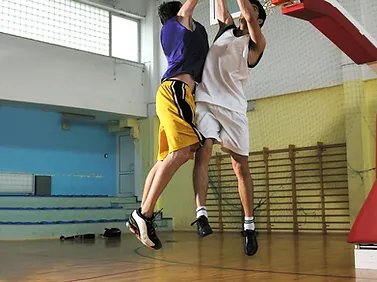Patellar Tendinopathy
Injury Guide

Patellar tendinopathy, commonly known as jumper’s knee, is a prevalent condition among athletes, particularly those involved in sports requiring repetitive jumping and explosive movements. This guide aims to shed light on the symptoms, causes, and effective rehabilitation strategies for athletes who have been diagnosed with patellar tendinopathy. At Latitude Physiotherapy, we understand the unique needs of athletes and are dedicated to providing personalized treatment plans to help you recover and regain optimal performance.
Symptoms:
Patellar tendinopathy is characterized by pain and discomfort in the tendon connecting the kneecap (patella) to the shinbone (tibia). Athletes experiencing this condition may observe persistent, localized pain just below the kneecap, tenderness and swelling around the patellar tendon, and stiffness that gradually worsens over time.
Anatomy:
The patellar tendon, also known as the patellar ligament, is a strong fibrous structure that connects the patella (kneecap) to the tibia (shinbone). It plays a vital role in transmitting forces from the thigh muscles to the lower leg, facilitating movements such as jumping, running, and kicking.
In the case of patellar tendinopathy, the structure and function of the patellar tendon are compromised. The condition primarily affects the mid-portion of the tendon, known as the enthesis, where it attaches to the patella. The tendon undergoes degenerative changes, including collagen disruption, neovascularization (formation of new blood vessels), and the presence of inflammatory cells.
The degeneration and collagen disruption weaken the tendon’s ability to withstand tensile forces, making it more susceptible to injury. Secondly, the presence of neovascularization and inflammatory cells contribute to pain and swelling within the tendon. This inflammatory response further perpetuates the degenerative process, creating a cycle of pain and dysfunction.
The anatomical implications of patellar tendinopathy also extend beyond the tendon itself. The surrounding structures, such as the quadriceps muscles and the patellofemoral joint, can be influenced as well. Muscle imbalances and weakness in the quadriceps can lead to increased stress on the patellar tendon, exacerbating the condition. Additionally, altered patellofemoral mechanics, such as poor tracking or abnormal contact between the patella and femur, can contribute to increased stress on the tendon during movements.
A proper rehabilitation program should aim to strengthen not only the quadriceps but also the posterior chain, and work towards reestablishing anterior to posterior chain balance. This approach will promote positive structural changes in the tendon in order to restore optimal function.
Causes:
Several factors contribute to the development of patellar tendinopathy. Overuse and repetitive strain from sports activities that involve frequent jumping or sudden changes in direction place excessive stress on the patellar tendon, leading to micro-tears and degeneration. Inadequate rehabilitation of previous knee injuries or insufficient recovery time can increase the risk of developing patellar tendinopathy. Muscle imbalances and weakness, particularly in the quadriceps and hamstring muscles, as well as poor biomechanics, can result in increased strain on the patellar tendon. Additionally, training errors such as rapid increases in intensity, volume, or frequency without proper conditioning or rest periods can overload the tendon and contribute to its degeneration.
Rehab Strategies:
Physical therapy is an effective treatment for patellar tendinopathy, as it can help improve the strength, flexibility, and load capacity of the tendon and the surrounding muscles. Some physical therapy strategies for patellar tendinopathy are:
- Eccentrics: These are exercises that involve lengthening the muscle while it contracts, such as lowering the heel from a raised position or squatting on a decline board. Eccentric exercises can stimulate tendon remodeling and reduce pain by increasing the tendon’s tolerance to tensile stress.
- Stretching: These are exercises that involve elongating the muscle to increase its range of motion and reduce stiffness. Stretching exercises can help prevent muscle spasm and shortening, which can increase the load on the tendon. Target the quadriceps, hamstrings, glutes, hip abductors and adductors, IT band, and piriformis muscles.
- Strengthening: Strengthening exercises can help balance the muscle-tendon unit and reduce the risk of re-injury. Strengthening exercises should include both open-chain and closed-chain exercises, such as leg press, leg extension, hamstring curl, hip abduction and adduction, glute machine, step up/down/over and wall sits.
Use code 44ZVECRP at medbridgego.com to learn our favorite basic exercise for patellar tendinopathy.
Individual response to treatment may vary depending on several factors, such as age, activity level, severity of symptoms, stage of tendinopathy and comorbidities. Therefore, it is important to consult with a qualified physical therapist who can assess your condition and prescribe a personalized rehabilitation program that suits your needs and goals.
Let’s
Work
Together
Ready to get started? Click here. General questions? Read our FAQ page. Have a specific question? Leave us a message!
